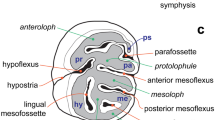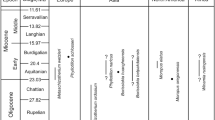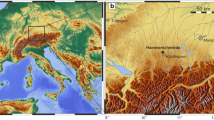Abstract
Zygolophodon turicensis (Schinz, 1824) is a widely distributed species across Europe from the early to late Miocene; however, it is poorly documented in Turkey. A Zygolophodon turicensis mandible fragment, preserving the m1 and the m2, is described from the middle Miocene (MN6) Avdan locality, which is a carbonous level (southwestern Turkey). The Avdan Zygolophodon turicensis contributes to the understanding of the evolution of this species.




Similar content being viewed by others
References
Blumenbach, J.F. (1799). Handbuch der Naturgeschichte, Sechste Auflage: Johann Christian Dieterich, Göttingen, (I)-XVI, (1)-708 p., 2 pls.
Borissiak, A. (1936). Mastodon atavus n. sp., der primitivste Vertreter der Gruppe M. angustidens. Paleozoologičeskoy Institut, 171–234.
Bray, E. E., & Evans, E. D. (1965). Hydrocarbons in nonreservoir-rock source beds: part 1. American Association of Petroleum Geologists Bulletin, 49, 248–257.
Erten, H., Sen, S., & Görmüş, M. (2014). Middle and late Miocene Cricetidae (Rodentia, Mammalia) from Denizli Basin (southwestern Turkey) and a new species of Megacricetodon. Journal of Paleontology, 88, 504–518.
Garevski, R., Garevska, B., & Markov, G. N. (2012). Remains of Zygolophodon turicensis (Proboscidea, Mammutidae) from the coal mines near Bitola, Republicof Macedonia. Historia Naturalis Bulgarica, 20, 157–162.
Gaziry, A. W. (1976). Jungtertiäre Mastodonten aus Anatolien (Türkei). Geologisches Jahrbuch, 22, 3–143.
Göhlich, U. B. (1999). Order Proboscidea. In G. E. Rössner & K. Heissig (Eds.) The Miocene land mammals of Europe (pp. 157–168). Munich: Verlag Dr. Friedrich Pfeil.
Göhlich, U. B. (2010). The Proboscidea (Mammalia) from the Miocene of Sandelzhausen (southern Germany). Palaeontologische Zeitschrift, 84, 163–204.
Gökçen, N. (1982). Denizli-Muğla çevresi Neojen istifinin ostrakod biyostratigrafisi. Yerbilimleri, 9, 111–131. [In Turkish]
Hakyemez, Y. (1989). Kale-Kurbalık (GB Denizli) bölgesindeki Senozoyik yaşlı çökel kayaların jeolojisi ve stratigrafisi. MTA Dergisi, 109, 9–21, Ankara. [In Turkish]
Hay, O.P. (1922). Further observations on some extinct elephants. Proceedings of the Biological Society of Washington, 35, 97–101.
Illiger, C. J. (1811). Prodromus systematis mammalium et avium additis terminis zoographicis uttriusque classis, Salfeld: Berlin. I-XVIII, 101–301.
Izart, A., Suarez-Ruiz, I., & Bailey, J. (2015). Paleoclimate reconstruction from petrography and biomarker geochemistry from Permian humic coals in Sydney Coal Basin (Australia). International Journal of Coal Geology, 138, 145–157.
Lόpez-Días, V., Urbanczyk, J., Blanco, C. G., & Borrego, A. G. (2013). Biomarkers as paleoclimate proxies in peatlands in coastal high plains in Asturias, N Spain. International Journal of Coal Geology, 116–117, 270–280.
Mazo, A. V. (1996). Gomphotheres and mammutids from the Iberian Peninsula. In J. Shoshani & P. Tassy (Eds.) The Proboscidea. Evolution and Palaeoecology of Elephants and Their Relatives (2nd edition, 1997) (pp. 136–142). New York: Oxford University.
Meyer, H. von (1867). Die fossilen Reste des Genus Tapirus. Palaeontographica, 15, 159–200.
Neubauer, T. A., Harzhauser, M., Kroh, A., Georgopoulou, E., & Mandic, O. (2015). A gastropod-based biogeographic scheme for the European Neogene freshwater systems. Earth-Science Reviews, 143, 98–116.
Osborn, H. F. (1929). New Eurasiatic and American Proboscideans. American Museum Novitates, 393, 1–22.
Osborn, H. F., & Granger, W. (1932). Platybelodon grangeri, three growth stages and a new Serridentinus from Mongolia: New York. American Museum Press, 537, 1–13.
Pancost, R. D., Baas, M., van Geel, B., & Sinninghe, D. (2002). Biomarkers as proxies for plant inputs to peats: an example from a sub-boreal ombrotrophic bog. Organic Geochemistry, 33, 675–690.
Peters, K. E., Walters, C. C., & Moldowan, J. M. (2005). The biomarker guide volume 1 (2nd ed.). Cambridge: Cambridge University Press.
Şafak, Ü. (2010). Güney-Buldan-Yenicekent-Babadağ-Kale (Denizli, GB Anadolu) çevresi Tersiyer çökellerinin ostrakod topluluğu ve ortamsal özellikleri. KSU Journal of Engineering Sciences, 13(2), 44–62. [In Turkish]
Sanders, W. J. (1996). Fossil proboscideans of the Manonga Valley. Tanzania: Journal of Vertebrate Paleontology, 16, 62–63.
Sanders, W. J., & Miller, E. R. (2002). New proboscideans from the early Miocene of Wadi Moghara, Egypt. Journal of Vertebrate Paleontology, 22, 388–404.
Sanders, W. J., Gheerbrant, E., Harris, J. M., Saegusa, H., & Delmer, C. (2010). Proboscidea. In L. Werdelin & W. J. Sanders (Eds.) Cenozoic mammals of Africa: Berkeley, Los Angeles (pp. 161–215). University of California Press: London.
Schinz, R.H. (1824). Naturgeschichte und Abbildungen der Säugethiere. Zürich.
Schinz, R. H. (1833). Über die Überreste organischer Wesen, welche in den Kohlengruben des Cantons Zürich bisher aufgefunden wurden. Denkschriften der allgemeinen Schweizerischen Gesellschaft für die gesammten Naturwissenschaften, 1(2), 39–64.
Schlesinger, G. (1917). Die Mastodonten des k.k. Naturhistorischen Hofmuseums. Denkschrift des Naturhistorischen Hofmuseums. Geologisch-Paläontologische Reihe, 1, 1–230.
Sickenberg, O., Becker-Platen, J. D., Benda, L., Berg, D., Engesser, B., Gaziry, W., Heissig, K., Hünermann, K. A., Sondaar, P. Y., Schmidt-Kittler, N., Staesche, K., Staesche, U., Steffens, P., & Tobien, H. (1975). Die Gliederung des höheren Jungtertiärs und Altquartärs in der Türkei nach Vertebraten und ihre Bedeutung für die internationale Neogen Stratigraphie (Känozoikum und Braunkohlen der Türkei. 17.). Geologisches Jahrbuch B, 15, 1–167.
Tassy, P. (1977). Découverte de Zygolophodon turicensis (Schinz) (Proboscidea, Mammalia) au Lieu-Dit Malartic a Simorre, Gers (Vindobonien Moyen): Implications paléoécologiques et biostratigraphiques. Geobios, 10, 655–659.
Tassy, P. (1985). La place des mastodontes Miocènes de l’ancien monde dans la phylogénie des Proboscidea (Mammalia): hypothèses et conjectures. Unpublished Thèse Doctorat ès Sciences, UPMC. 1–861.
Tassy, P. (1986). Nouveaux Elephantoidea (Mammalia) dans le Miocène du Kenya. Cahiers de Paleontologie, Éditions du Centre de la Recherche Scientifique, Paris, 135 pp.
Tassy, P. (1989). The “Proboscidean datum event”: how many proboscideans and how many events? In E. H. Lindsay, V. Fahlbusch, & P. Mein (Eds.) European Neogene mammal chronology (pp. 237–252). New York: Plenum Press.
Tassy, P. (1990). Phylogénie et classification des Proboscidea (Mammalia): Historique et actualité. Annales de Paléontologie, 76, 159–224.
Tassy, P. (1996). The earliest gomphotheres. In J. Shoshani & P. Tassy (Eds.) The Proboscidea: evolution and palaeoecology of elephants and their relatives (pp. 89–91). Oxford: Oxford University Press.
Tobien, H. (1975). The structure of the Mastodont molar (Proboscidea, Mammalia), part 2: the zygodont and zygobunodont patterns. Mainzer Geowissenschaftliche Mitteilungen, 4, 195–233.
Tobien, H. (1996). Evolution of zyogodons with emphasis on dentition. In J. Shoshani & P. Tassy (Eds.) The Proboscidea. Evolution and palaeoecology of elephants and their relatives. Oxford University Press, pp. 76–85.
Vacek, M. (1877). Ueber Reste von Mastodon aus tertiären Ablagerungen Oesterreichs. Verhandlungen der K.K. Geologischen Reichsanstalt 52–53.
Wang, S.Q., Yu L., Duangkrayom J., Yang X. W., He W., & Chen S.Q. (2017). A new species of Gomphotherium (Proboscidea, Mammalia) from China and the evolution of Gomphotherium in Eurasia. Journal of Paleontology, 1–15. e1318284.
Waples, D. W. (1985). Geochemistry in petroleum exploration. Boston: Springer Verlag 232 p.
Xie, S., Nott, C. J., Avsejs, L. A., Maddy, D., Chambers, F. M., & Evershed, R. P. (2004). Molecular and isotopic stratigraphy in an ombrotrophic mire for paleoclimate reconstruction. Geochimica et Cosmochimica Acta, 68(13), 2849–2862.
Yakupoğlu, T., & Bayhan, E. (2017). Yatağan Havzasındaki (Muğla/GB Türkiye) Neojen yaşlı sedimanter kayaçların sedimantolojik ve petrografik özellikleri. Journal of the Institute of Natural & Applied Sciences, 22(2), 120–131. [In Turkish]
Zhou, W., Xie, S., Meyers, P. A., & Zheng, Y. (2005). Reconstruction of late glacial and Holocene climate evolution in southern China from geolipids and pollen in the Dingnan peat sequence. Organic Chemistry, 36, 1272–1284.
Acknowledgements
We thank Mihály Gasparik (Hungarian Natural History Museum), Pascal Tassy (Muséum national d’histoire natürelle, Paris), Peter Koenigshof (Senckenberg Research Institute, Frankfurt am Main) and the anonymous reviewer for their useful comments and suggestions. We also appreciate contributions of Tamer Koralay (Pamukkale University Department of Geological Engineering) especially in field study. We also thank M. Tamer Ayvaz (Pamukkale University Department of Civil Engineering) for taking the pictures of the specimens. Our final thanks goes to Meltem Uzunoğlu Erten (Pamukkale University Department of English Language and Literature) for her translations.
Author information
Authors and Affiliations
Corresponding author
Ethics declarations
Conflict of interest
The authors declare that they have no conflict of interest.
Additional information
Publisher’s note
Springer Nature remains neutral with regard to jurisdictional claims in published maps and institutional affiliations.
Rights and permissions
About this article
Cite this article
Erten, H., Koralay, D.B. A Zygolophodon turicensis (Proboscidea, Mammalia) mandible fragment from the Kale-Tavas basin (Denizli, Turkey). Palaeobio Palaeoenv 100, 1077–1082 (2020). https://doi.org/10.1007/s12549-020-00422-7
Received:
Revised:
Accepted:
Published:
Issue Date:
DOI: https://doi.org/10.1007/s12549-020-00422-7




